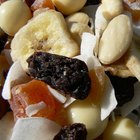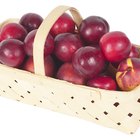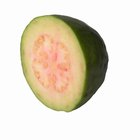
In a few favored locations around the country, fresh fruit and berries are available through most of the year. Everywhere else, the options most of the year are mediocre fresh fruit trucked from thousands of miles away, or frozen fruit. Frozen fruit is often the better option, because it's harvested at its ripest and processed immediately to preserve the best flavor. Adapting your cake recipes to frozen fruit is relatively straightforward.
Fruit Layer
A few recipes call for the fruit to be used as a layer or swirl within the cake. Usually the fruit is at least partially cooked beforehand, and the cooking juices thickened to make a flavorful sauce. You can substitute frozen fruit for the fresh fruit called for in your recipe, but it's important to note that the frozen fruit will shrink more during cooking then fresh fruit and will release more juice. You might need to cook slightly more fruit, and concentrate the juice by simmering it down to half its original volume before thickening it. Once the fruit is cooked and cooled, it can be used in the same way as fresh fruit.
Mixed-In Fruit
Most cakes incorporating fruit or berries call for them to be stirred into the batter before it goes into the pans. Large frozen fruit such as peaches or mango slices should be cut into bite-sized pieces, but berries can usually be used whole. It's best to bake the fruit while it's still frozen, because if thawed it will release its juices into the batter and make it watery. Deeply colored berries will also color the batter if they're thawed, which is usually undesirable.
A Few Tips
The thinner and lighter your cake batter is, the more likely it is that your fruit will sink to the bottom during baking. To counter this, cut your fruit into smaller pieces for thin-battered recipes. You can also toss the frozen fruit with flour, which will help it remain in place. If you're using especially fragile fruit, such as frozen raspberries, it's best to push them gently into the batter after it's in your pans rather than stirring them into the batter. Cakes leavened with baking soda tend to give blueberries an odd green tinge, so it's best to use baking powder for blueberry cakes.
Upside-Down Cakes
The simplest cakes to make with frozen fruit are upside-down cakes, which bake on top of a layer of fruit. Frozen apples, pineapples, pears and other fruits with moderate amounts of juice can be used without thawing. Grease the bottom of your pan liberally, mix your sugar with cornstarch or flour to thicken the juices, and proceed as you would with fresh fruit. For juicier fruits such as peaches and berries it's best to thaw them first, draining and saving the juices. Thicken the juice separately, then pour it over the fruit and proceed as you would for fresh fruit.
Related Articles

Adding Raspberries to a Lemon Cake Mix

How to Freeze a Prickly Pear Cactus

How to Soak Dried Fruit

How Are Strawberries Processed?

How to Freeze Raspberries
Easy Peach Cobbler Recipe
Do You Defrost Frozen Peaches Before ...

How to Cook Agar-Agar Jam

Can You Prepare Fruit Pizza Ahead?

How Long Can a Brandy-Soaked Fruitcake ...

How to Freeze Whole Peaches & Plums

How to Make Meat Tender With Fruit

Desserts That Can Be Made With Puff ...
Easy Strawberry Shortcake Recipe
How to Freeze a Fruitcake

How to Peel Guava
How to Stop the Cherries Falling to the ...
How Long Is it Safe to Keep Frozen ...

How to Boil Blackberries & Sugar for a ...

How to Cook a Fruit Cobbler in the ...
References
Writer Bio
Fred Decker is a trained chef and certified food-safety trainer. Decker wrote for the Saint John, New Brunswick Telegraph-Journal, and has been published in Canada's Hospitality and Foodservice magazine. He's held positions selling computers, insurance and mutual funds, and was educated at Memorial University of Newfoundland and the Northern Alberta Institute of Technology.
Photo Credits
Eising/Photodisc/Getty Images